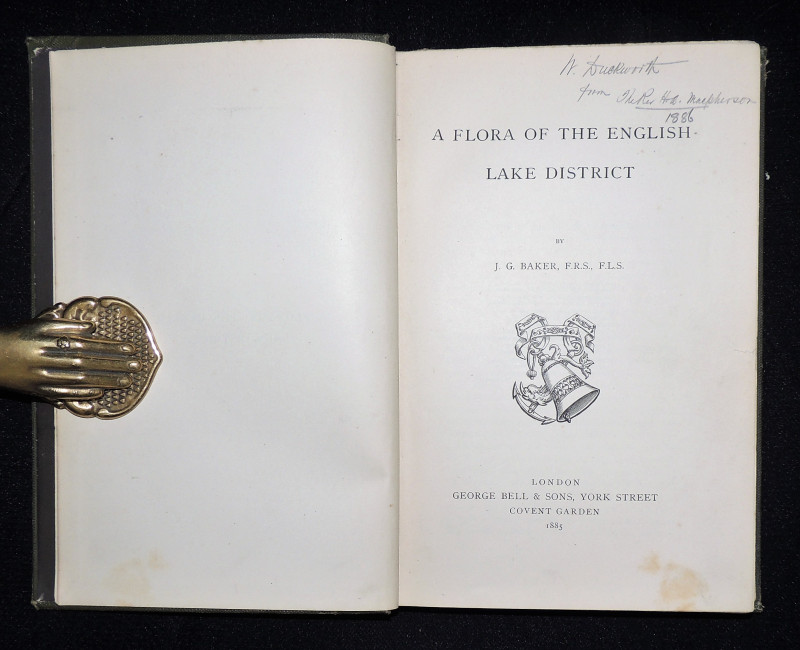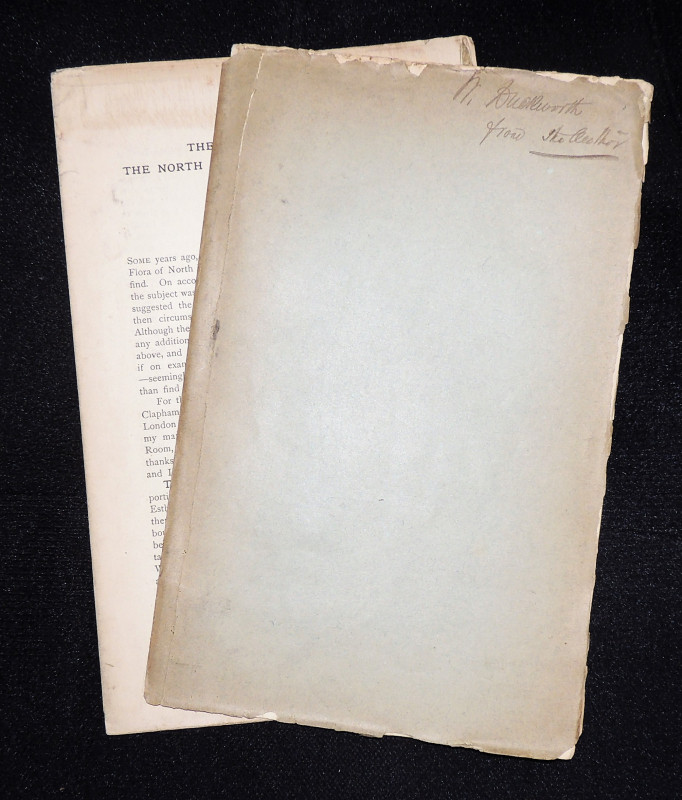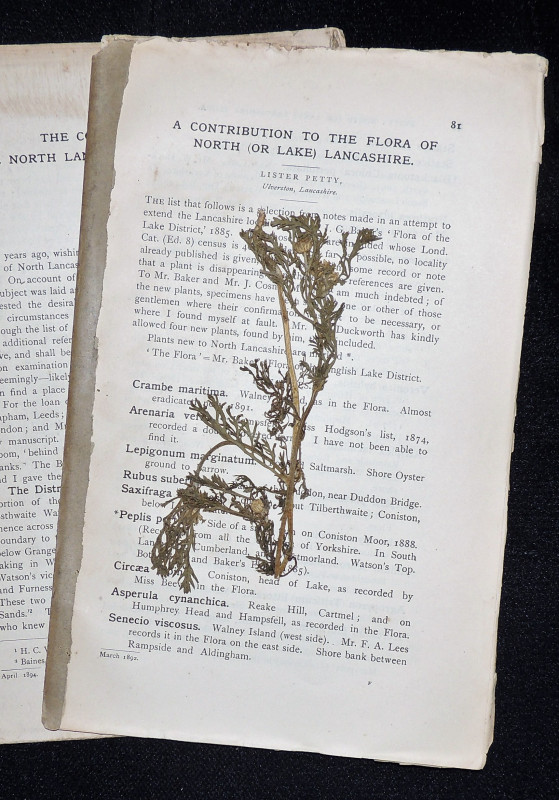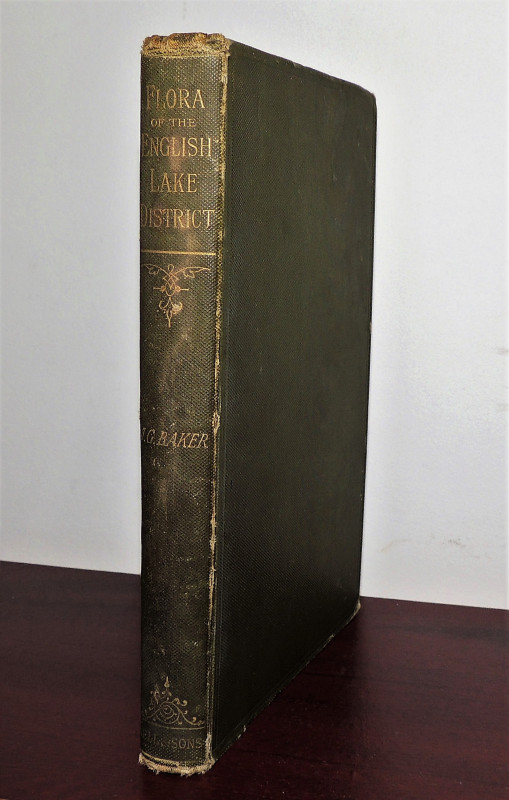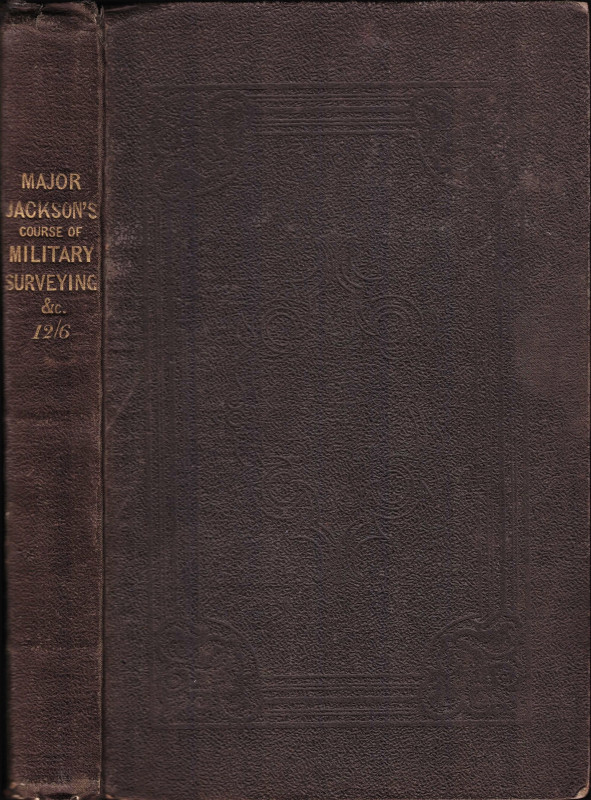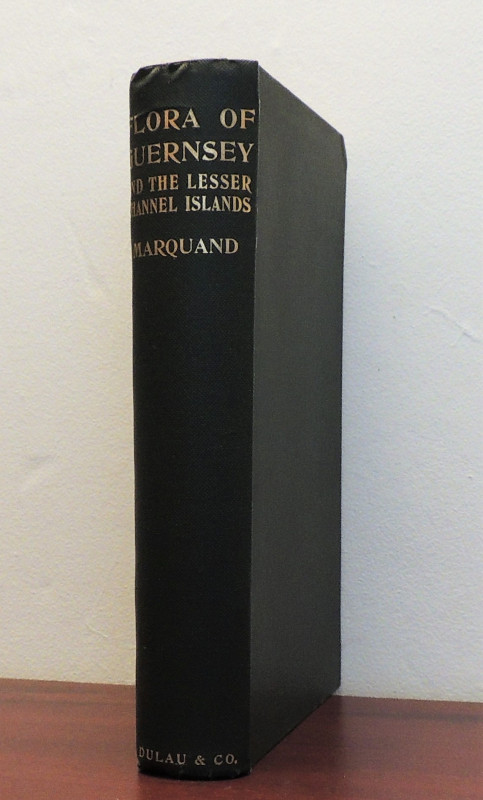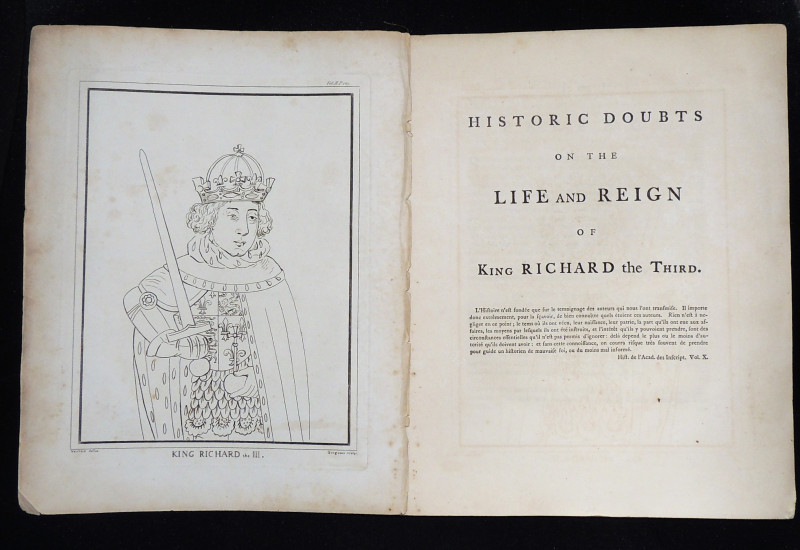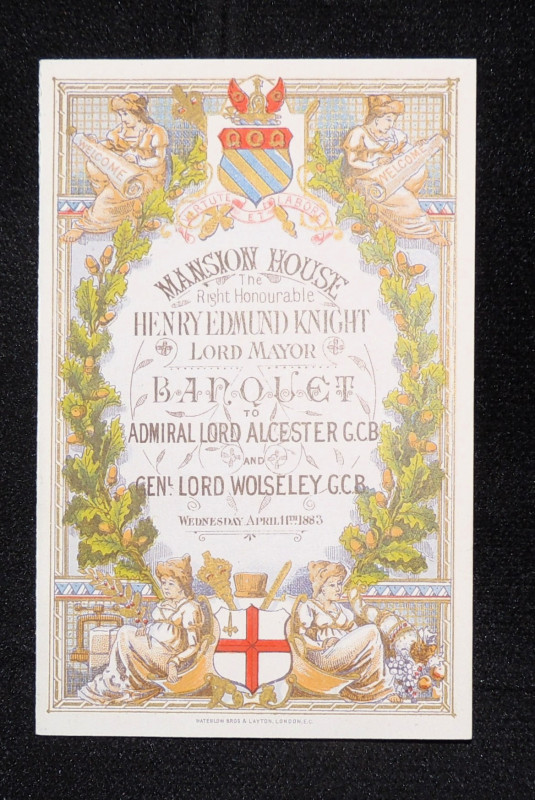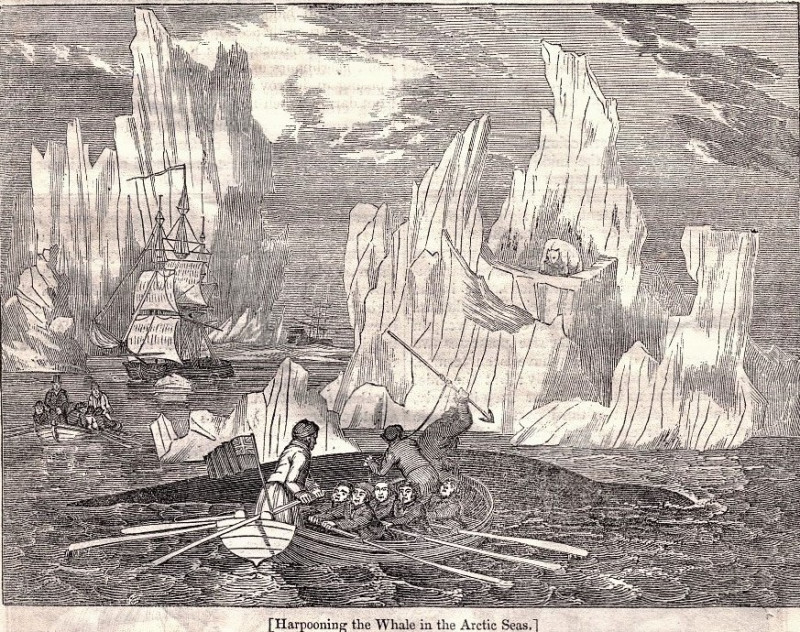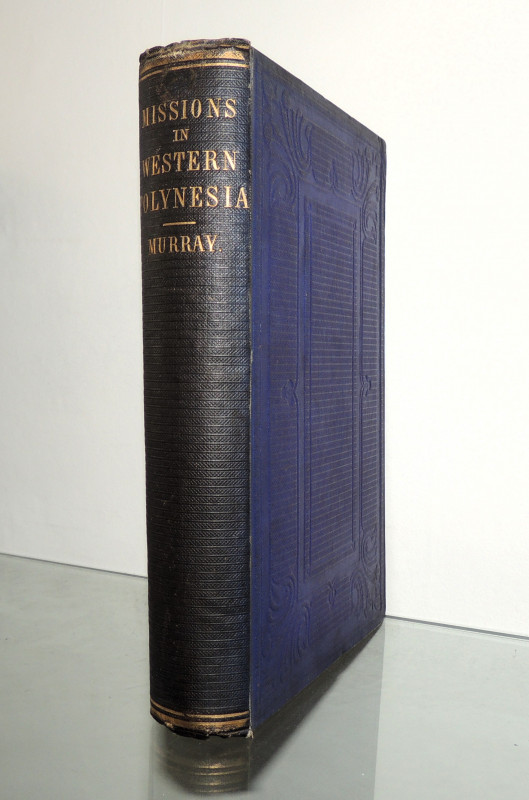English Lake District plant-hunting archive
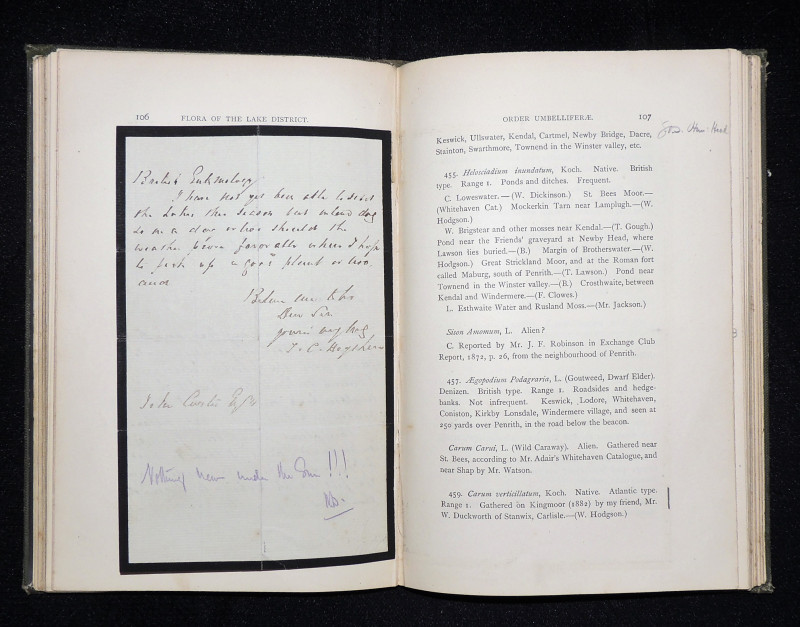
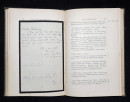
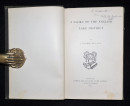



Book Description
An archive of primary sources from the collection of William Duckworth, Botanist, Plant Collector, Naturalist:
Baker, J. G.
A Flora of the English Lake District. George Bell. London. 1885. Octavo. viii, 262, (1)pp. Original cloth, worn, gilt to spine. Bookseller’s plate of Charles Thurnam and Sons, Carlisle to fep. A well-used significant copy with fascinating primary source British plant-hunting provenance and associated material.
• Signed presentation copy from Hugh Macpherson dated 1886 to William Duckworth.
• Inserted letter (Black edged after the death of his father, the naturalist John Heysham, MD) dated July 7 1837, 2 pages, handwritten, to the naturalist and illustrator John Curtis from the Carlisle naturalist, Thomas Coulthard Heysham, regarding his plant-hunting discovery of this species, and offering to send a specimen, to John Curtis. The letter is annotated and initialled by Duckworth: “Nothing new under the Sun!!!”. Tipped in opposite the entry in the book regarding the discovery of Carum verticillatum “Gathered on Kingsmoor (1882) by my friend, Mr W. Duckworth of Stanwix, Carlisle”. Curtis used the specimen sent to illustrate plate 680 of British Entomology: Being Illustrations and Descriptions of the Genera of Insects Found in Great Britain and Ireland, and credited Heysham in the text.
• WD’s marginal annotations recording discoveries and endpaper addenda. Newspaper clipping hand dated in pencil 17.08.07 regarding the discovery of Allium scorodoprasum by Mr Duckworth and plant label tipped in to rfep.
• A dried pressed specimen of Whorled Caraway (Carum verticillatum) identified in the letter from T C Heysham to Curtis is loosely inserted into the first of the pamphlets below.
Together with two associated pamphlets loosely inserted:
• Petty, Lister
A Contribution to the Flora of North (or Lake) Lancashire. Pamphlet. 1891. Detached paper wraps. Signed dedication from the author to Mr Duckworth.
• Petty, Lister
The Constituents of the North Lancashire Flora, 1597 (?)-1893. Pamphlet April 1894
Provenance:
“That Heysham was a good botanist, there can be no doubt … Perhaps the plant with which his name is most associated is the Whorled Caraway (Carum verticillatum). the story of which is perhaps best told in Hodgson’s* own words : “ Kingmoor, northward of Carlisle, reported from that station in 1882, by Mr. Wm. Duckworth, who flattered himself for a time with being the first recorder of that rarity. It has since transpired that the plant was gathered on Kingmoor in 1837 by the late T. C. Heysham, Esq.” James Murray 1857.
“Heysham’s record of the Whorled Caraway—Carum verticillatum Koch—from Kingmoor has often been quoted, but it is not generally known that he first found this local plant at Newby Cross and sent a specimen to Curtis who gave a beautiful coloured figure of it in his fourth [sic] volume, plate 680.” F. H. Day. Natural History of Cumberland. 1945. CHNS.
John Curtis (1791-1862) English entomologist and illustrator. His monumental masterwork, British Entomology: Being Illustrations and Descriptions of the Genera of Insects Found in Great Britain and Ireland, still widely considered as the finest nineteenth century work on the subject. Plate 680 is labelled in the volume XV “Carum verticillatum, Whorled Caraway, from Newby Cross was communicated by T C Heysham Esq.”
Rev. Hugh Alexander Macpherson, M.A. (1858-1902)
A naturalist with a particular interest in ornithology. He acquired T C Heysham's records in the 1880's.
Soon after his arrival in Carlisle in 1882 Macpherson got to work, in collaboration with William Duckworth, on The Birds of Cumberland.
William Duckworth Botanist, plant collector, naturalist. Of Carlisle and Ulverston. Contributor of plant records to Hodgsons Fl. Cumberland 1898*, Lister Petty and others. Instrumental in Carlisle Museum's Natural History Record Bureau, Britain's first local environmental records centre, collecting and collating records, from amateur naturalists.
Thomas Coulthard Heysham 1791-1857
Transactions of the Carlisle Naturalists Society:
James Murray (1857) “To students of local Natural History, the name of Heysham has no unfamiliar sound, and I think it almost impossible to find a work of any importance in any department of local Natural History, without this name occurring with more or less frequency. The late Rev. H. A. Macpherson, when he published his “Birds of Cumberland,” in 1886, dedicated it to JOHN HEYSHAM, M.D., and THOMAS COULTHARD HEYSHAM, both eminent Naturalists”.
Frank Day (1907) “Reference to Cumberland coleoptera in published works are not numerous, but may be found in the following :—“ British Entomology,” by Curtis, 1823-40 (abbreviated Curt. Brit. Ent.). “ Illustrations of British Entomology,” by J. F. Stephens, 1827-35 (abbreviated Ste. Illus.). " Manual of British Coleoptera,” by J. F. Stephens, 1839. (abbreviated Ste. Man.).
The records in these three works are for the most part on the authority of the late T. C. Heysham… The only resident coleopterist in the past who attempted any systematic work at the subject, was T. C. Heysham, who, after collecting and studying insects of all Orders for close on half a-century, established the foundation upon which all subsequent work must be based. He died in 1857.”
*NOTE: This item is from a private library collection of British Floras which we are currently cataloguing for sale. From the same collection we have available The Flora of Cumberland by W. Hodgson where it is written that Mr. Wm. Duckworth flattered himself for a time with being the first recorder of that rarity. "It has since transpired that the plant was gathered on Kingmoor in 1837 by the late T. C. Heysham, Esq."
Author
Thomas Coulthard Heysham; Rev. Hugh Alexander Macpherson; William Duckworth; J.G. Baker; John Curtis; Lister Petty
Date
1837-1894
Friends of the PBFA
For £10 get free entry to our fairs, updates from the PBFA and more.
Please email info@pbfa.org for more information
